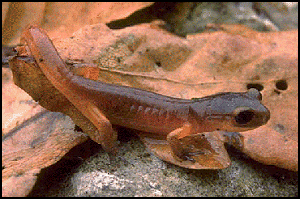
Monterey Ensatina (Ensatina eschscholtzi eschscholtzi)
by Marc S Staniszewski

Monterey Ensatina (Ensatina eschscholtzi
eschscholtzi)
Description
7 - 16cm; A slender, somewhat fragile-looking
salamander with a smooth, shiny dorsum and flanks consisting of 11 to 13 distinct costal
grooves. In healthy individuals the tail is well-developed and fleshy (longer than body in
males, shorter in females) with a distinct constriction near the base (the point at which
the tail can be amputated as a defensive mechanism). The head is rounded with huge, dark
soulful-looking eyes. Colour patterns are so variable across some of the subspecies that
they may soon, once again, be designated distinct species. All species possess a pale
white or yellow belly.
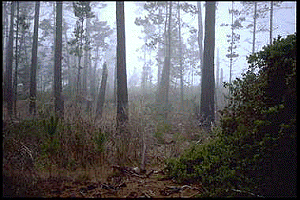
Typical Ensatina Habitat - Del Monte Forest, Monterey
Range, Habitats & Habits
The Ensatina is distributed along the Pacific
Coast of North America, from central California, Oregon and Washington to southern British
Colombia. Extensive and relict populations exist in the Sierra Nevada Mountains. Its
favourite habitats are the cool, humid maple, redwood, oak, cedar and pine forests along
coastal regions, in valleys and up to an elevation of 12,000 feet. It is regularly found
on the verges of slow flowing streams and rivers and loves skulking about in damp leaves
and grasses in search of invertebrates. Extremely secretive in disposition, it possesses
several defensive mechanisms. The tail is easily amputated when grasped and as the severed
muscles retract this causes the tail to wriggle, allowing the salamander an escape. This
species is also known to secrete milky alkaline toxins from glands in the tail which are
extremely distasteful and irritable to most predators.
Sub-Species Identification
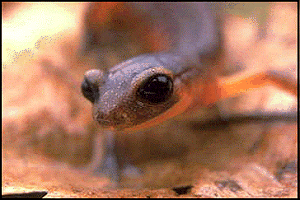
Monterey Ensatina (Ensatina eschscholtzi eschscholtzi)
Note nasolabial grooves on the snout of this male
Monterey Ensatina - (E.e.eschscholtzi):
The nominate form and the most familiar. A brick-red or light brown, slender dorsum with
lighter (sometimes orange) limbs. Range - coastal southern California from the Del Monte
Forest in the Monterey peninsular to northwest Baja.
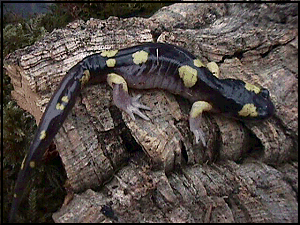
Small-blotched Ensatina (Ensatina eschscholtzi croceator)
is probably the rarest of the ensatinas
Small or Yellow-blotched
Ensatina - (E.e.croceator):
Black or dark brown dorsum patterned in small and irregular pale yellow or yellow-green
blotches. A large blotch exist behind each eye.
Range - Rather limited, scattered distribution in the foothills of Kern County,
California. I found this species in small numbers near Mount Pinos.
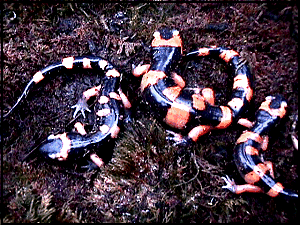
Large-blotched Ensatina (Ensatina eschscholtzi klauberi)
These two males and female (centre) were discovered
under a log beneath two feet of snow
Large-blotched Ensatina - (E.e.klauberi):
Very similar in appearance to E.e.croceator, however more stockily built with much
larger blotches, the colours of which range from pale yellow to orange. One of the largest
and most beautiful Ensatina forms.
Range - East of San Diego in the vicinity of alpine habitat. I found this species in an
area close to Mount Palomar under large fallen pine trunks. It was extremely cold
(sub-zero in some places) and snowfall was evident. Where its range overlaps with E.e.croceator
or E.e.eschscholtzi, an integrade may occur.
Oregon Ensatina - (E.e.oregonensis):
Very similar to E.e.eschscholtzi although dorsal coloration tends to be a lighter
brown or even fawn with varying black flecks and belly peppered with dark speckles. Rather
more lizard-like in appearance compared to other ensatina's.
Range - The most widespread species occurring from south-western British Columbia down to
the north-central reaches of California. Where its range overlaps with the Sierra Nevada
Ensatina E.e.platensis (mainly in Shasta County, California) an attractive brown
with speckled orange integrade occurs.
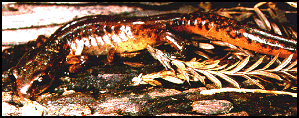
Adult female Painted Ensatina (Ensatina eschscholtzi
picta)
discovered in a rest area on Route 1 Northern California
Painted Ensatina - (E.e.picta):
One of the most attractive ensatinas with a dark brown to black dorsum revealing a
conspicuous network of whitish yellow to orange striations.
Range - Coastal southern Oregon and northern California.
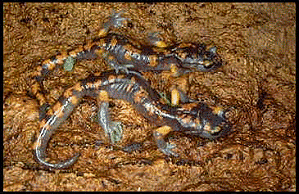
A beautiful pair of Sierra Nevada Ensatina
(Ensatina eschscholtzi platensis)
Sierra Nevada Ensatina - (E.e.platensis):
Possibly the most beautiful ensatina. The dorsum background colour is dark brown or black
and covered with conspicuous orange or sometimes red blotches. The head is large and the
body laterally compressed. The tail is very fleshy and stubby. Range - Small pockets
throughout the Sierra Nevada mountains and is particularly abundant in the humid redwood
groves of the Sequoia and King's Canyon National Parks.
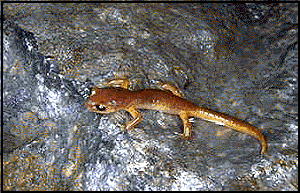
A sub-adult Yellow-eyed Ensatina
(Ensatina eschscholtzi xanthoptica)
Yellow-eyed Ensatina - (E.e.xanthoptica):
Almost identical to the Monterey ensatina apart from two distinguishing features; as its
name suggests its upper eye possesses a yellow eye patch and the dorsum can vary from
brown to a orange brown.
Range - widespread throughout the San Francisco Bay area Down to the western slopes of the
Sierra Nevada mountains. It is particularly abundant throughout the state parks of the
region and I found hundreds of these creatures skulking about in between leaves and loose
bark, especially near stream and rivers.
Captive Care
Housing
Ensatina demand a spacious, cool and damp terrarium with plenty of dark hiding places.
They will not tolerate dry conditions. Maintain no more than six individuals within a 10
gallon aquarium because males of this genus are territorial to a certain extent.
Substrate
The terrarium should be divided into three parts; In one corner there should be small,
shallow water pan, no more than 5cm deep. This pan serves two purposes; one it allows the
salamanders to bath should the rest of the terrarium dry out, and two it promotes higher
humidity. Surround the water pan with lots of smooth rocks and pebbles and pad out the
gaps loosely with sphagnum moss. This provides the salamanders with ideal humid resting
places. The remainder of the vivarium should consist of about 5cm of a chipped forest bark
and deciduous leaf loose mixture. I also like to encourage some wild grasses and ivy (Hedera)
to grow (maintaining them in their pots which are concealed by the mixture). Finish off
this by placing several pieces of cork bark, bogwood or swamp wood on top of the mixture,
providing these secretive salamanders with more hiding places. Such a setup must be kept
moist and also cleaned out every 7 - 10 days to prevent too much fungal and/or bacterial
growth.
Lighting
There is certainly no requirement for UVB lighting (unless live plants are maintained
in the terrarium) because ensatina are primarily nocturnal or crepuscular. Locating the
terrarium in a well lit place (but not in direct sunlight) will provide them with the
photoperiods necessary to promote breeding.
Temperature/Humidity
Heating is the most important and difficult aspect of ensatina care. Unless a
temperature below 70°F. can be constantly maintained then there really is no point
attempting to keep them as they will simply die. Heat stress is a well documented fatality
in these and many other plethodontid salamanders. The optimum temperature range is in fact
48 - 64°F. (preferably to 58°F. only for E.e.platensis and E.e.oregonensis.
Temperature governs reproductive, feeding and hibernation behaviour. In the wild these
salamanders are able to move deep underground to escape heat. In captivity they do have
such opportunities. In some areas it may be necessary to install some sort of air
cooling/conditioning device, or I have personally utilized an old refrigerator, converted
into a glass fronted cool terrarium. Humidity is also important. As ensatina are
plethodontid or lungless salamanders, the exchange of oxygen and waste gases through the
skin demands a moist environment. Mist the terrarium three or four times daily, using a
slightly acidic water (clean rainwater which is free from pesticides/herbicides is ideal).
DO NOT close off ventilation points to increase humidity. This will result in stale air
and fungal/bacterial explosions which will prove far more harmful. Always ensure there is
excellent ventilation.
Feeding/Watering Regimes
The water pan contents must be changed on a daily to two day basis. Misting of the
cage should take place just before lights are switched on/near dawn and just before
dusk/lights are switched off. Food for these salamanders consists mainly of insects,
preferably centipedes, spiders and small crickets. They will also take small earthworms,
waxworm, freshly sloughed mealworm and even their own young. Crickets should be gut-loaded
with carrots, oranges and other nutrients. Food can be dusted every other sitting with a
vitamin supplement such as Rep-Cal. Ensatina hunt mainly at night so introduce a
sufficient number of these food items during dusk.
Hibernating
Ensatina MUST be hibernated from December to February at temperatures of around
40°F.. I hibernate my specimens in a refrigerator but ensure that the container is given
air at least twice a day. Only those healthiest ensatina which possess sufficient body
fats should be hibernated. Yearlings and two yearlings should be cooled to a minimum of
50°F. In the wild Ensatina also aestivate but this is nether essential or recommended for
indoor captives.
Breeding
Breeding can be quite difficult. I had greatest success by maintaining my adults in an
outdoor unheated greenhouse in central England. Correct hibernation, temperature and
humidity regimes are essential in reproduction. Courtship takes place in September or
October, usually after heavy downfalls, which can be mirrored by increasing the misting
duration until the terrarium is sodden. Males are distinguished by their longer tail, more
slender build and presence of nasolabial grooves running from the nostrils to the upper
lip. Eggs are laid in moist depressions in moss or leaf litter. Adult females (and
sometimes males) are one of the few salamanders to guard and moisten the 8 - 14 large
yellow or whitish eggs that are deposited. It is thought that these secretions contain
anti-bacterial and fungal chemicals. In captivity such parental behaviour does not always
occur, especially if the salamanders are constantly disturbed. It is therefore wise to
check on the eggs only occasionally. Larval development takes place
entirely within the gelatinous egg shell. Miniature replicas of the parents hatch out
after 55 - 80 days and must be separated from the adults who are likely to eat them.
Sexual maturity is achieved after 2 to 3 years.
For the first time in 1998 I was able to breed the large-blotched ensatina. My
female deposited 12 large (8mm diameter) eggs and then spent 12 weeks brooding over them.
Occasionally she would leave them in search of food during which another female would
brood the eggs. Near hatching I experimented by removing a single egg. During hatching the
female ate 2 young. I was able to retrieve the rest. The removed egg collapsed and did not
hatch proving that female care is absoluetly essential through the entire brooding period.
Picture below show the eggs and a hatchling.
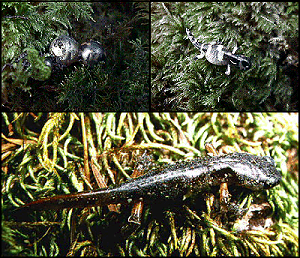
Top left - Large blotched ensatina (E.e.klauberi)
eggs
Top right - hatchling Large blotched ensatina (E.e.klauberi)
Bottom - Juvenile Painted Ensatina (Ensatina eschscholtzi picta)
Other Comments
In captivity, these salamanders are known to regularly live for at least 12 years. I
have had a pair of Sierra Nevada ensatina living in an unheated greenhouse for nearly 10
years and they were adults when I acquired them. Handling of ensatina must be kept to a
minimum. The tail can be easily amputated at the slightest touch, and a regrown tail is
rather stumpy, discolored and distinctly less attractive.
Please note that all
Aneides
species and other amphibians are strictly protected within U.S.
State and National Parks and should not be collected unless you have special
authorisation to do so.
References
Information gathered from the following books/persons was used in the generation of this page.
1.) The Audubon Society Field Guide to
North American Reptiles & Amphibians - Bebler & King, Knopf Publishing
2.) Discovering Sierra Reptiles and Amphibians - Harold E.Basey, Yosemite Association
| 3.) Amphibians in
Captivity (TFH) - Marc Staniszewski (1995) |
![[image]](Images/tfhbook.jpg) |
All text and photo's -
Copyright ©1996-2002 Marc Staniszewski
Most recent revision: 06/08/2002